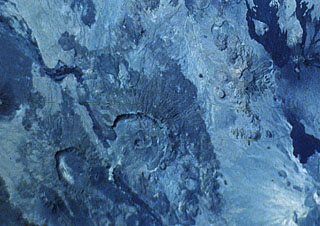Report on Nabro (Eritrea) — 15 June-21 June 2011
Smithsonian Institution / US Geological Survey
Weekly Volcanic Activity Report, 15 June-21 June 2011
Managing Editor: Sally Sennert.
Please cite this report as:
Global Volcanism Program, 2011. Report on Nabro (Eritrea) (Sennert, S, ed.). Weekly Volcanic Activity Report, 15 June-21 June 2011. Smithsonian Institution and US Geological Survey.
Nabro
Eritrea
13.37°N, 41.7°E; summit elev. 2218 m
All times are local (unless otherwise noted)
An eruption from Nabro that started on 12 June continued to produce a plume. Based on analyses of satellite imagery, the Toulouse VAAC reported that during 15-20 June plumes comprised mostly of water and sulfur dioxide rose to altitudes of 6.1-7.9 km (20,000-26,000 ft) a.s.l. Ash was occasionally detected near the volcano. Satellite imagery posted on MODIS Web showed a dark brown ash plume fanning out to the SW on 19 June. A thermal satellite image acquired at night on 19 June revealed a 15-km-long lava flow that had traveled NW. A high-altitude plume, likely rich in water vapor, rose from the erupting vents and a diffuse ash-rich plume drifted SW.
News articles stated that ash had covered a well-known mine that produces edible salt, and had contaminated food and water sources. During 15-16 June several airlines cancelled some domestic and international flights, including in and out of Addis Abeba (Ethiopia), neighboring Djibouti, and Khartoum (Sudan).
Geological Summary. The Nabro stratovolcano is the highest volcano in the Danakil depression of northern Ethiopia and Eritrea, at the SE end of the Danakil Alps. Nabro, along with Mallahle, Asavyo, and Sork Ale volcanoes, collectively comprise the Bidu volcanic complex SW of Dubbi volcano. This complex stratovolcano constructed primarily of trachytic lava flows and pyroclastics, is truncated by nested calderas 8 and 5 km in diameter. The larger caldera is widely breached to the SW. Rhyolitic obsidian domes and basaltic lava flows were erupted inside the caldera and on its flanks. Some very recent lava flows were erupted from NNW-trending fissures transverse to the trend of the volcanic range.
Sources: NASA Earth Observatory, Toulouse Volcanic Ash Advisory Centre (VAAC), Addis Fortune, Bloomberg, NASA MODIS Rapid Response System

